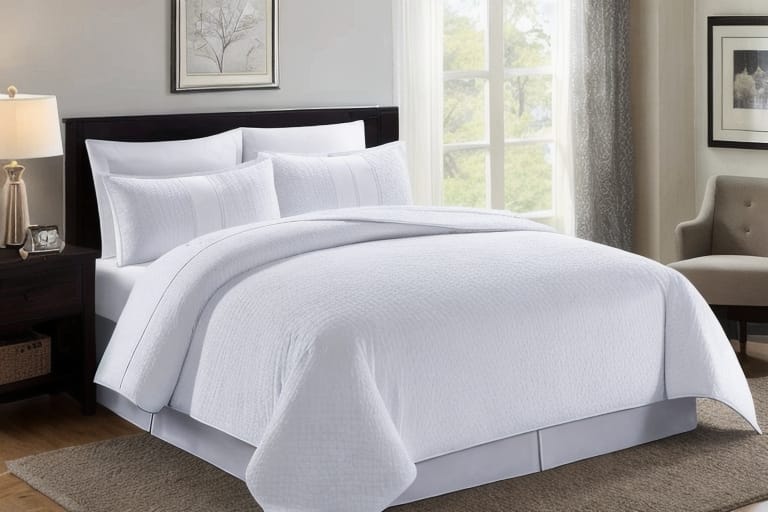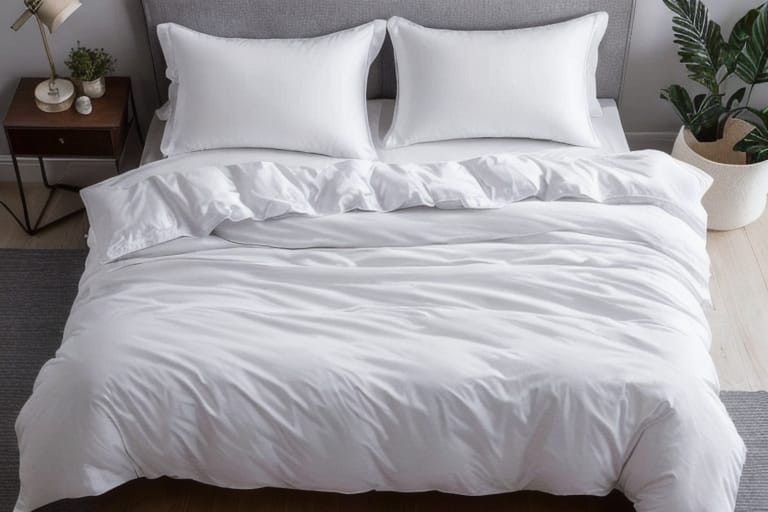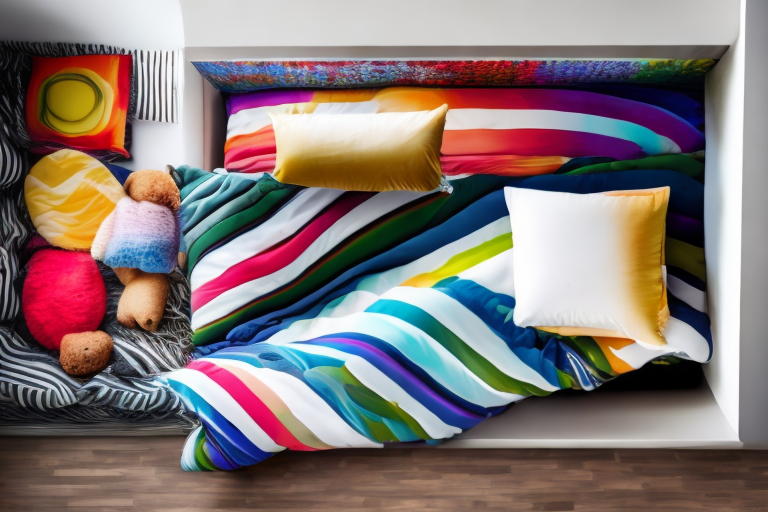Do you love the fluffy comfort of a down-filled duvet, but dread overheating at night? You’re not alone. Many hot sleepers worry that down duvets will be too warm and cause night sweats. However, with the right fill power, tog rating, and breathable shell, down duvets can provide cozy comfort without the heat.
This beginner’s guide will explore how down duvets can work for hot sleepers, compare different fill options like goose down and duck down, and provide tips for choosing the best down comforter to meet your needs – whether you sleep hot, cold, or somewhere in between.
What Makes Down Duvets So Cozy

Down duvets are prized for their light, airy warmth regulation. The fluffy down fill consists of tiny clusters that trap air and insulate heat, while remaining breathable. This allows humidity and body moisture to dissipate instead of building up – leading to better temperature regulation.
The alternative is heavier synthetic fills made from polyester or other manmade fibers. These trap heat and moisture more easily, causing hot sleepers to wake up sweaty.
Down comes from ducks and geese and is rated by fill power. This indicates the loft – how much air a certain weight of down can trap:
- 550+ fp = Excellent loft and insulation
- 450-550 fp = Very good quality down
- 350-450 fp = Decent loft and warmth
- Under 350 fp = Lower quality, less insulation
Higher fill power down is lighter and more efficient at providing warmth for its weight. However, lower fill powers can still work well depending on factors like climate and sleeper habits.
Can Down Duvets Work for Hot Sleepers?
Even natural down has excellent moisture-wicking properties to prevent sweating at night. The porous structure allows humid air to flow through and dissipate instead of building up. As long as the duvet has a breathable lightweight shell, a down duvet can vent body heat year round.
The key is choosing the right tog rating – a measure of insulation. The general guidelines are:
- 9+ tog – Very warm for cold climates
- 7-9 tog – Warm and versatile for most environments
- 4.5-7 tog – Cooler for hot climates and warm sleepers
- 1-4.5 tog – Ultra lightweight for tropical regions
Consider your usual sleep environment – do you blast the AC or keep the heat cranked? What bedding and pajamas do you sleep in? Your individual comfort zone will determine what tog rating feels best.
Goose vs. Duck Down Duvets
Goose and duck down have slight differences that impact suitability for hot sleepers:
Goose Down
- Very fluffy and insulating
- Exceptional warmth-to-weight ratio
- Higher fill power than duck
- More expensive
Duck Down
- Not as fluffy as goose
- Good insulation at lower cost
- Slightly heavier than goose
- Generally a lower fill power
For hot environments and night sweats, duck down is often the better choice as it won’t overheat as easily. However, with a lightweight goose down and low tog rating, either can work well year round.
Finding Breathable Down Duvets for Summer
Look for these features in a lightweight, breathable down duvet for staying cool in the summertime:
- Low tog rating – 4.5 or under is ideal
- Thin, lightweight construction
- High thread count sateen cotton or linen shell
- 100% down with high fill power for maximum loft
- Generous sizing to prevent compacting of fill
Here are some excellent summer-weight down duvets loved by hot sleepers:
| Product | Fill Material | Tog Rating | Shell | Price |
|---|---|---|---|---|
| Istikbal Fitted Quilted Duvet | Grey Duck Down | 3.5 | 300 TC Cotton | $179 |
| Luxome Coolmax Down Comforter | Goose Down | 3.9 | Coolmax Cotton | $329 |
| Paradise Luxury Hungarian Goose Down | Goose Down | 3.5 | 400 TC Sateen | $349 |
With features optimized for airflow and cooling insulation, the right down duvet can work wonders – even for perpetually overheated sleepers.
Finding the Right Down Comforter for You
Beyond insulating value and temperature regulation, down duvets come in all shapes and sizes. Consider these factors when selecting the one for your needs:
1. Size
Make sure your duvet is generously sized to your mattress to prevent the down from compacting too densely. Bigger is better when it comes to dispersing insulation.
2. Design
Many duvets have beautiful patterns like checkerboard stitching or decorative diamond weaves to prevent fill from shifting. While pretty designs are nice, focus more on the fill quality and materials first before aesthetics. No amount of stitching can compensate for cheap, low grade down.
3. Hypoallergenic Properties
About 3-5% people have down allergies from exposure to dust mites and feathers. Seek out duvets advertised as “hypoallergenic down” which undergo extra processing to remove allergens. Required certifications like Oeko-Tex guarantee the safety of materials.
4. Ethical Sourcing
To ensure humane practice, look for “responsibly sourced down” in accordance with animal welfare standards. Established brands like Patagonia trace their entire supply chain to guarantee ethical harvesting. While costlier, cruelty-free down promotes sustainability for the wellbeing of both animals and humans.
5. Budget
Down duvets span a wide range – from bargain buys under $100 to luxury at over $1000. In general, here’s what to expect:
- Good entry-level duvets with decent 550 fp down run $100 – $250
- Mid-range 700 fp ethically sourced down costs $250 – $500
- Luxury 800 fp+ goose down with premium materials reaches $500 – $1000+
No need to break the bank for a quality duvet. Even budget down alternative options using synthetic PrimaLoft insulation and bamboo fiber fills imitate down properties rather well. Just ensure any budget duvet still uses high thread count, breathable shell fabrics optimized for temperature regulation.
Conquering Night Sweats with Down Bedding

Do you wake up drenched in sweat, then shiver from the clamminess? Night sweats plague many people apart from just menopausal women. Hot flashes can strike men and women of all ages.
The source of overheating comes down to managing body heat. When core temperatures spike at night, you sweat to release all that pent-up warmth. Finding bedding that diffuses heat yet still insulates can help regulate sweating.
Here are some key approaches to combatting night sweats using breathable down duvets:
Choose Lower Tog Ratings
Highly insulating bedding causes overheating leading straight to sweaty sleepless nights. The best tactic is choosing lightweight down specifically tailored for hot sleepers, like these:
- 4.5 tog or Under
- Lightweight Shell – 300+ TC cotton, linen, or bamboo
- Fill Power Over 600
With less insulation and more breathability, this type of down duvet ventilates heat before sweat even forms.
Skip Excess Bedding Layers
Piling on layers of top sheets, blankets, and bedspreads traps heat and sweat next to your skin. Simplify bedding for better airflow:
- Use only a fitted sheet
- Add either quilt OR duvet, not both
- Limit blankets to breathable natural fibers like light cotton, bamboo, or linen
Having too many pieces causes bedding to press together compacting fill and eliminating that all-important breathability factor.
Adjust Room Temperature
Cooler ambient air lets bedding breathe better. Set your thermostat to 60-67°F at night – the optimal range for sleeping without sweating or shivering. Layer pajamas instead of cranking the heat.
Also invest in a quality mattress protector. These wick moisture and protect mattresses from sweat stains and odors.
By really focusing on breathability and airflow, there are quality down duvets perfect for conquering night sweats – even for those who run super hot!
The Impact of Duvet Covers on Cooling
A duvet’s outer shell plays a critical role in temperature regulation. Seemingly minor factors like weave type and thread count add up when promoting cooling airflow:
Weave and Fabric
- Sateen cotton boasts a light, silky-smooth face with cozy brushed underside perfect for dispersing body heat.
- Percale is crisp yet breathable, ideal for cooling airflow.
- Linen excels at moisture-wicking and ventilation.
- TencelTM lyocell fibers regulate body temperature with unparalleled cooling and softness.
Thread Count
200 to 400 tc fabrics provide optimal balance of breathability and durability. Go too dense like 1000 tc luxury sheets and airflow suffers.
Construction
Details like decorative weave panels provide zones of breathability while preventing shifting.
Care
Follow included washing instructions to prevent compacting fill over time. Line or flat drying preserves loft better than high heat drying.
When your duvet cover checks off all the boxes for optimal temperature regulation, you’ll stay sweat-free and comfy!
Enjoy Down Duvets in Every Season
The right down duvet keeps you cozy year-round. In winter, fluffy insulation locks in precious body heat to keep you toasty. When summer rolls around, lightweight breathability prevents sweating when temperatures rise.
With two duvets, you get the best of both worlds. Simply swap out your winter duvet for a summer-weight one with lower insulation. Fluff and air out the duvets regularly to maximize loft and cooling potential in each season.
Hot Weather Essentials
Here are the best approaches to buying down duvets tailored for warm weather and climates:
Lightweight Warmth
- Fill Power: 600-750
- Fill Weight: Under 30 oz (850 grams)
- Tog Rating: 3 – 4.5
Breathable Fabrics
- 300+ Thread Count Shell
- Lightweight Cotton, Linen, or Tencel
- Corner Loops to Secure Duvet
Generous Sizing
- King fits Queen bed
- Queen fits Full/Double
- Twin fits Twin XL
Oversized duvets stay fluffy. Plus you can use one year-round! In winter, double up same-size duvets for extra coziness.
Seeking Cooler Duvet Alternatives?
For those extremely prone to overheating, alternative duvet materials provide lightweight warmth perfect for hot sleepers.
Mulberry Silk:
The ultimate hot weather filling! 100% mulberry silk insulates with unparalleled breathability to whisk away moisture and regulate body temperature.
- Naturally hypoallergenic
- Encasing keeps fill evenly distributed
- Care requires dry cleaning or hand washing
Cost: $$-$$$
Alpaca Wool:
Air trapped in the fluffy wool insulates minus the bulk of sheep wool. Ultra-fine fibers feel heavenly soft and lightweight.
- Temperature regulating
- Resilient yet cozy loft
- Eco-friendly cruelty free source
Cost: $$-$$$
TENCELTM Lyocell Fibers:
This sustainable wood pulp bedding offers moisture control and a cool-to-the-touch feel.
- Excellent for temperature regulation
- Ultra-soft with breathable structure
- Often blended with cotton, linen or bamboo
Cost: $
While not as lofty and insulating as down, these alternative materials sleep cool enough for even the hottest sleepers.
The Best Down Duvets for Children
Down comforters make wonderful bedding for kids – when properly selected:
Match Tog Rating to Age
Focus on breathability and adjusting insulation as kids grow:
Ages 0-3: 3.5-4.5 tog medium-warmth duvet breathability
Ages 3+: 5-7.5 tog for insulation as needed
Teens: Adult warmth ratings apply
Choose generously oversized duvets allowing room to grow. Kids can use their favorite duvet for years to come.
Prioritize Safety
Double check labels for chemical safety certifications like Oeko-Tex, especially for young children. Skip decorative applique or intricate embroidery which can loosen and become choking hazards.
Clean with Care
Routinely wash and sanitize bedding to prevent allergen buildup. Most down duvets require professional laundering to preserve delicate down clusters from damage over years of use.
Properly cared for hypoallergenic down bedding makes the ultimate cozy, breathable bedding for children of all ages. Investing in quality materials safeguards health and promotes better sleep for the entire family.
Why Proper Bedding Matters for Sleep Health
Waking up sweaty and restless negatively impacts mental and physical health. Without quality REM sleep, kids and adults alike suffer:
Effects of Poor Sleep:
- Daytime fatigue
- Cognitive impairment
- Weakened immunity
- Increased disease risk
By supporting the body’s natural temperature regulation capabilities, breathable down bedding allows deeper, healthier sleep.
Optimizing comfort encourages quality slumber for the whole family. By taking the time to find just the right down bedding tailored to your needs, you invest in better rest night after night.
The Future of Sleep Tech and Down Bedding
While down duvets offer unmatched warmth and comfort, research constantly aims to improve bedding with the latest technology:
Phase Change Materials (PCMs)
Integrate thermally regulating wax-like PCMs directly into textile fibers, absorbing and releasing heat to maintain optimal body temperature.
Cooling Gel
Micro-encapsulated beads release cooling gel comforters when your body heat rises, creating a temperature-regulating bedding.
Smart Textiles
Embed fiber optics and microsensors to track sleep metrics like temperature and humidity fluctuations, heart rate, movement.
Nanotechnology
Engineer bedding at microscopic levels, embedding silver nanoparticles or capillary action to pull heat away from the body.
While still in early development, innovative bedding promises a future of ultra customized, responsive environments promoting the most restful sleep imaginable.
Stay Cozy and Cool with the Right Down Bedding
The takeaway? With careful selection optimized for breathability, down comforters can work beautifully year round – even for hot, sweaty sleepers. Consider your unique climate, bedding needs, and budget to find your just-right match.
Down’s inimitable fluffiness comes from nature itself – an ultimate cradle to welcome restful nights of blissful slumber. By taking the time to find your perfect balance of coziness and cooling,
Frequently Asked Questions
What is the benefit of a down duvet for hot sleepers?
Despite down’s reputation for warmth, it still allows excellent breathability and temperature regulation. The fluffy down fill creates airflow to vent body heat, while the lightweight tog rating prevents overheating. As long as the duvet uses a breathable outer shell material, down comforters can work for hot sleepers and night sweats.
What fill rating should I choose?
For lightweight seasonal duvets, look for fill powers over 600fp. This indicates higher quality down with better loft and insulation properties per ounce. Duck down tends to rate less than goose down; however duck down resists compacting better over time. For year-round use in varying climates and seasons, a midrange fill power around 550fp with a versatile tog rating offers the best balance.
How do I know if a down duvet is ethically sourced?
Look for certifications like “Responsible Down Standard” indicating humane practice according to animal welfare organizations guidelines. Traced supply chains prevent unethically live-plucked down from entering global markets. Reputable brands specifically promote their ethical sourcing such as Patagonia’s Traceable Down line. Checking that your down duvet uses cruelty-free materials ensures payments support sustainable businesses.
What fabric weaves work well for lightweight duvets?
High thread count sateen woven cotton and linen provide optimal breathability and temperature regulation. Avoid extremely dense 1000tc+ fabrics, as too tight a weave prevents that all-important airflow. Percale offers a smooth, crisp handfeel that still breathes well. TencelTM Lyocell woven with plant fibers creates exceptional cooling moisture-control.
Should I get two duvets for summer and winter?
Owning two duvets prevents having to stuff an over-insulated fluffy winter duvet into a summer duvet cover. The compressed fill loses loft and cannot provide cooling airflow. Storing seasonal bedding allows proper loft regeneration. Furthermore, you can double up duvets in winter for extra cozy warmth then use singly on warmer spring and fall nights. Having options ensures you always sleep comfortably.








